Which ahadith are authentic? Hadith is a collection of the Prophet Muhammad’s sayings and actions (PBUH). The Hadith now serves as an additional source of Islamic religious law alongside the Qur’an. After the Qur’an, the Hadith is the second pillar upon which every Muslim bases his beliefs which allows the Muslims to be educated about the Sunnah of the Holy Prophet Muhammad (PBUH).
Mat’n and Isnad are two parts that make up an authentic hadith. The Hadith’s text is referred to as Mat’n, and its transmission line is referred to as Isnad.
The Status of Sunnah And Hadith
Hadith comes as second among the four main sources of Islamic law. just after the Quran. Consensus (ijma’) and analogy (qiyas) are the other two sources.
It was the Prophet Muhammad’s duty to spread the word of Allah (SWT) and also, show the truth that the Quran has revealed.
Categories of Hadith
In general, a Hadith is divided into the following categories;
1. Sahih: The genuine Traditions, the authentic ones.
2. Moothaq: Almost like the Sahih but the narration is not as strong as those of the Sahih.
3. Hassan: The fair Traditions although inferior in matters of authenticity.
4. Dha’eef: The weak Traditions which are not so reliable.
In Shari’ah (Islamic Constitution) deeds and actions are divided into five classes:
1. Fardh or Wajib: An obligatory duty the omission of which is Islamically punishable.
2. Mustahab: An action that is rewarded but whose omission is not punishable.
3. Mubaah: An action that is permitted but legally indifferent.
4. Makrooh: An action that is disapproved by the Shari’ah but is not under any penalty.
5. Haram: An action that is forbidden and Islamically punishable.
Which Books of Ahadith are Authentic?
The Quran and the Sunnah of the Islamic prophet, which are his words, deeds, and silent approval, are both regarded as the explanations of the divine revelation, and the record of them (i.e., hadith) serves as the foundation of Islamic law, make it imperative that the authenticity of hadith be established (Sharia).
The hadith also provides guidance on matters ranging from specifics of religious duties (such as Ghusl or Wudu, ablutions for salat prayer), to the proper forms of greetings, to the significance of benevolence to slaves, even though there are only a small number of verses in the Quran that deal with the law.
1 – Three Primary Ways of Determining The Authenticity of Hadith
One of the most effective and practical ways to determine the authenticity of a hadith is to find other narrations of the event or saying, and then judge them on their credibility and strength.
Examining the chain of transmission, which passes each hadith from the Holy Prophet Muhammad (PBUH) to the person who compiles the hadith, is a fundamental component of hadith studies. The matn, the hadith’s primary text or body, differs from the isnad and the commentary.
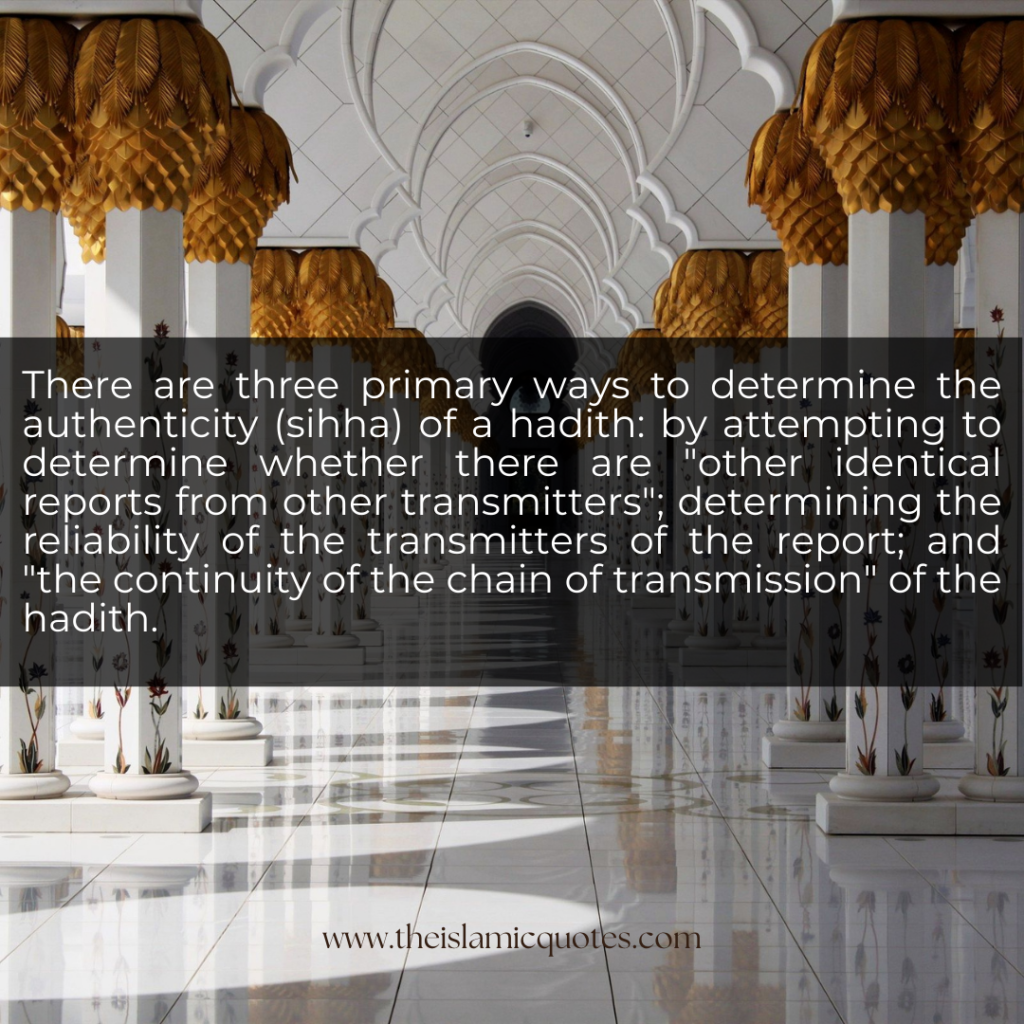
2 – Truthfulness of Islamic Tradition
Imam Al-Shafi’i is known as the most notable scholar for elevating the mechanism for testing the truthfulness of hadith in Islamic law,
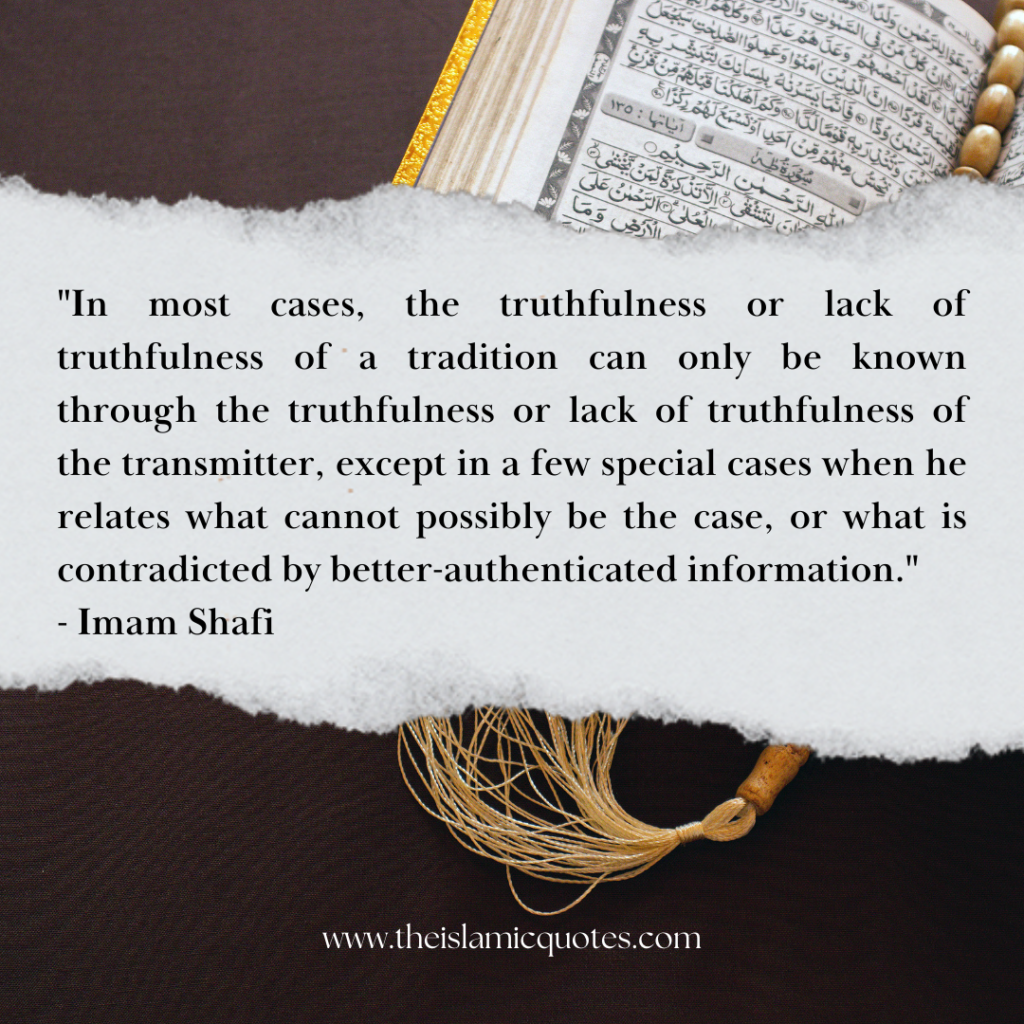
3 – The Chain of Hadith: How Does Hadith Travel?
The following narration explains how the hadith have traveled and transmitted to us over time.

4 – Criteria To Be A Sahih (Sound) Hadith
The criteria to determine the soundness of hadith are as follows;
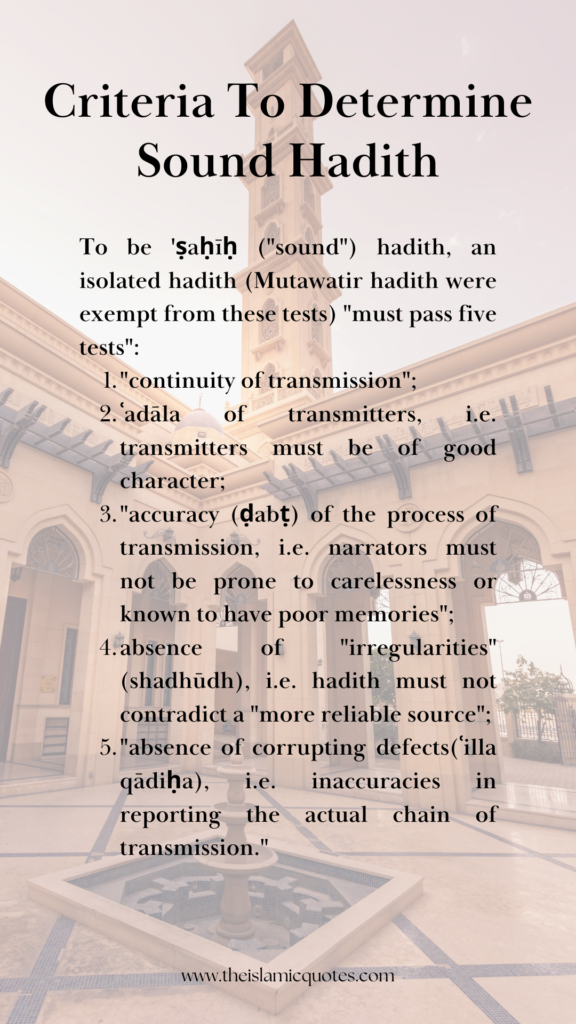
5 – Biographical Evaluation of The Transmitters of Hadith
The field of hadith studies known as ilm al-rijl, or the “knowledge of men,” includes the study of hadith transmitters’ biographies as a significant subfield. The narrators that make up the sanad are these. Some Quranic passages serve as the foundation for ilm ar-rijal. Good-memory and linguistic-skilled transmitters “could be regarded competent (bit)”.
“Trustworthy” or “thiqa” ratings for transmitters with both “adala” and “bit” are two examples of ratings. Honest transmitter ratings are given to those that are adala but exhibit evidence of negligence. The outcome of this research was “huge biographical dictionaries” that could be compared to specific hadith’s isnads.
Not all transmitters underwent this evaluation and rating. Due to their proximity to the Prophet, it has long been believed that the Companions of the Prophet (a.s.) collectively possess moral turpitude and as such, all of them already possess adala without further assessment.
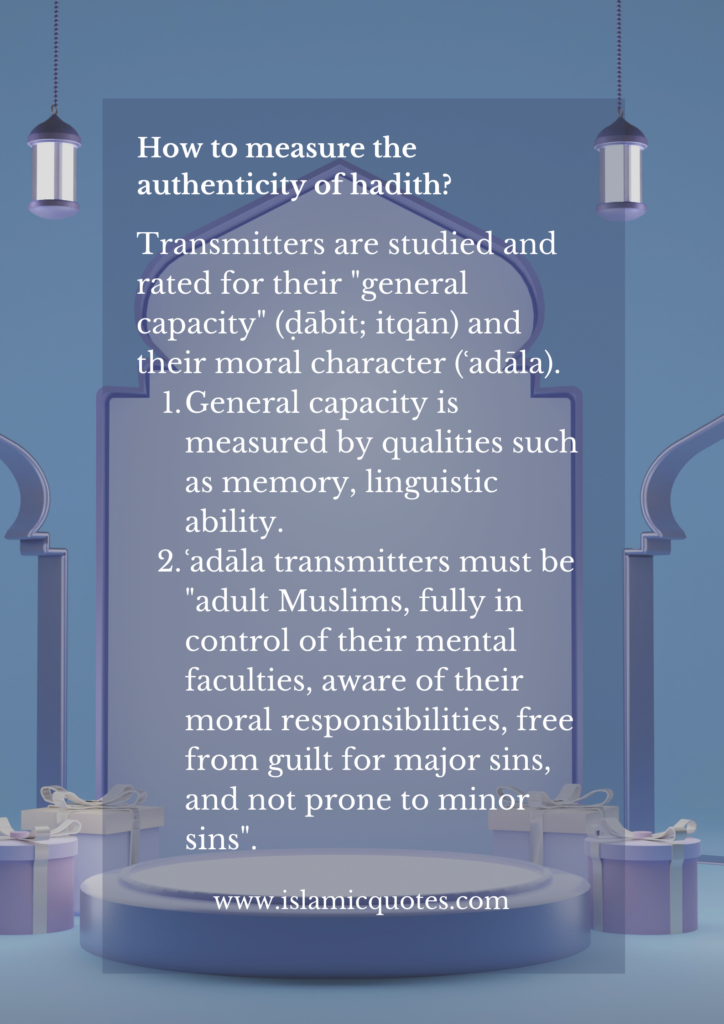
6 – Principles of Writing Hadith
According to Shaykh Muhammad Zakariya al-Kandahlawi, Imam Bukhari stated the following as requirements for a muhaddith.
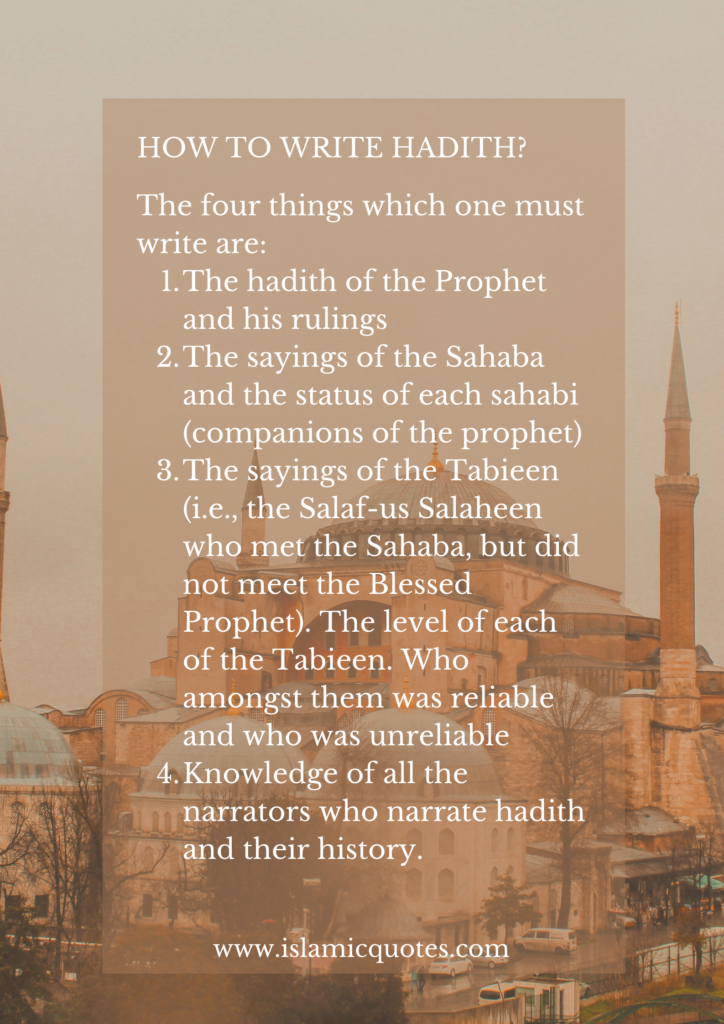
7 – Chain of Continuity And Presence of Transmitter
The continuity of the chain of transmission of the hadith is the second factor to be considered after evaluating the transmitters’ overall aptitude and moral uprightness.
It must be demonstrated that the transmitters obtained the prophet’s accounts “in an appropriate way from the previous authority in the chain.” Early academics of religion emphasized the significance of the sanad.
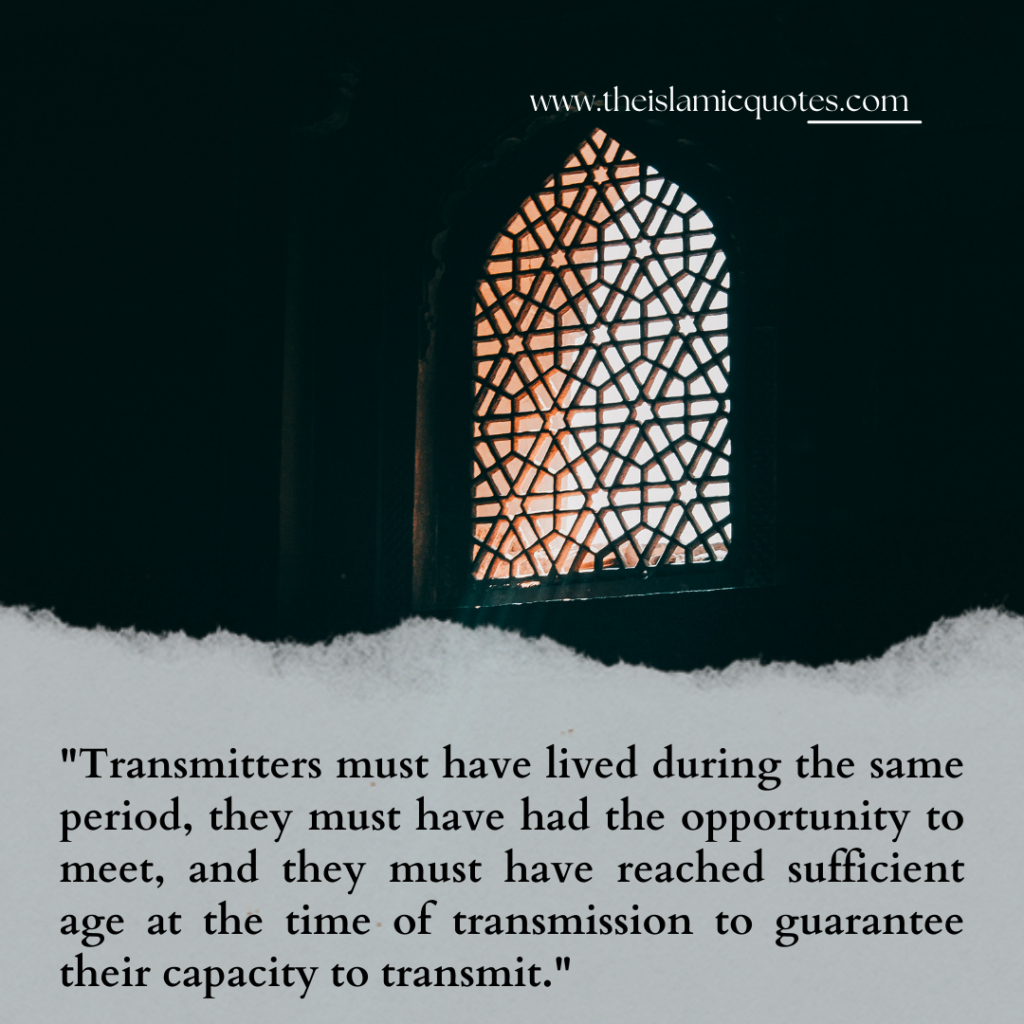
8 – Importance of Tracing The Sanad
According to Muhammad Ibn Sirin, the custom of paying special attention to the sanad dates back to the generation that came after the Companions. However, the Companions of the Prophet were, according to the more persuasive of the two perspectives, those who were exempt from needing a sanad, however others, like al-Qurtubi, also include the more senior followers.
This is because all companions are regarded as upright, reliable hadith transmitters, making a mursal hadith transmitted by a companion permissible.

FREQUENTLY ASKED QUESTIONS (FAQs)
Q. What is the most authentic source of hadith?
The Sunni school of thought believes the following to the most authentic sources of hadith:
- Sahih Bukhari, collected by Imam Bukhari
- Sahih Muslim, collected by Muslim
- Sunan Abu Dawood, collected by Abu Dawood
Q. Can a hadith be false?
There have been several instances where a hadith has been proven false. Hence, our first source of guidance should be the Holy Quran. Moreover, any hadith found in contradiction to the teachings of the Holy Quran must be deemed inauthentic.
Q. What is the weakest hadith?
The classifications of hadith include but, are not limited to; Al-Aziz (rare and sound hadith), Maqbul (weak but acceptable), and Mardud (weak and not acceptable).
Q. What is accurate grading of hadith?
Thus, there are three broad categories into which all valid hadiths can be divided: sahih, those having an unbroken and trustworthy line of transmission, and a book that does not go against conventional wisdom; Daif (weak), those whose matn or transmitters have received harsh criticism; hasan (good), those with an incomplete sanad or with transmitters of dubious authority.
Q. What are the 4 types of hadith?
Hadith is divided into four additional types such as Qudsi (Divine), Marfu`(Elevated), Mauquf (Stopped), Maqtu`(Severed).






